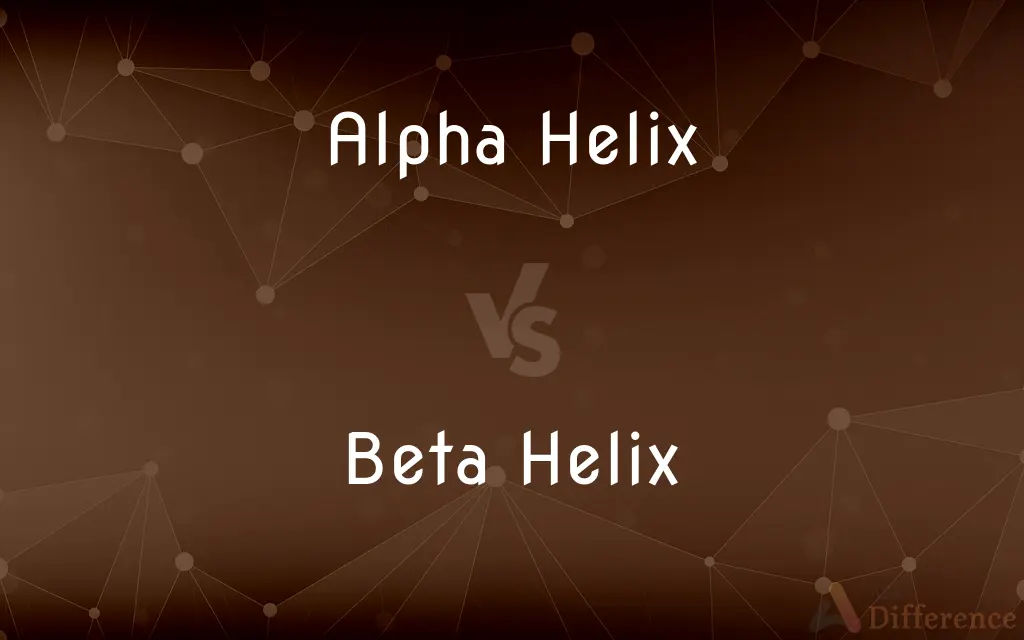Alpha Helix vs. Beta Helix — What's the Difference?
By Tayyaba Rehman — Published on November 29, 2023
Alpha Helix is a right-handed coiled rod-like structure in proteins, whereas Beta Helix is a less common left-handed helical structure found in some proteins and peptides.

Difference Between Alpha Helix and Beta Helix
Table of Contents
ADVERTISEMENT
Key Differences
The Alpha Helix, a crucial protein structure, intricately coils with a right-handed orientation, presenting a quintessential spiraled formation. On the contrary, the Beta Helix, often overshadowed in typical protein discussions, establishes itself with a rare left-handed coiling, forming a distinct spiral pattern.
Diving into their structural minutiae, the Alpha Helix demonstrates hydrogen bonds stabilizing its coils, forming between every fourth amino acid. The Beta Helix, with its unique left-handed twist, establishes hydrogen bonds differently, between adjacent turns of the helix, crafting its distinct stabilizing mechanism.
In the realm of stability, the Alpha Helix commands universal recognition due to its prevalence and well-studied nature in protein structures. Alternatively, the Beta Helix, while not as commonly featured in proteins, draws interest through its specialized existence in specific peptides and protein regions.
Biochemical properties of the Alpha Helix provide structural stability and functionalities in proteins across numerous biological contexts. The Beta Helix, while less encountered, has sparked interest, particularly in studies of antifreeze proteins, reflecting its specialized application in biological scenarios.
In summary, the Alpha Helix occupies a vital spot in protein structure understanding, facilitating numerous biochemical processes through its stable and prevalent form. Conversely, the Beta Helix, embodying an understudied yet fascinating structural alignment, invites further exploration into its unique applications and occurrences in proteins.
ADVERTISEMENT
Comparison Chart
Helical Turn
Right-handed
Left-handed
Hydrogen Bonding
Between every fourth amino acid
Between adjacent helical turns
Prevalence
Common in proteins
Less common
Structural Stability
Highly stable
Varies
Notable Applications
Various biochemical functions
Specialized, e.g., antifreeze proteins
Compare with Definitions
Alpha Helix
A spiral arrangement in proteins introduced by Linus Pauling and Robert Corey.
The specific pitch and rise of the Alpha Helix are vital for its function in various proteins.
Beta Helix
A rare protein secondary structure that forms a large, tubular shape.
The Beta Helix in the enzyme provided a channel for substrate binding.
Alpha Helix
A motif in proteins where each turn of the helix involves 3.6 amino acid residues.
Mutations that disrupt the Alpha Helix can lead to protein misfolding and disease.
Beta Helix
A helical arrangement of beta-strands that can be right-handed or left-handed.
The study highlighted the functional significance of the left-handed Beta Helix in certain proteins.
Alpha Helix
A common secondary structure in proteins characterized by a right-handed coiled strand.
The stability of the Alpha Helix is often maintained by hydrogen bonds.
Beta Helix
A coiled structure in proteins that consists of several stacked beta-sheet formations.
The Beta Helix is stabilized by hydrogen bonds between parallel or antiparallel strands.
Alpha Helix
A coiled structure in proteins stabilized by internal hydrogen bonding between backbone atoms.
The discovery of the Alpha Helix revolutionized our understanding of protein structures.
Beta Helix
A helical assembly of beta-strands, typically found in some bacterial enzymes.
The structure of the enzyme revealed a unique Beta Helix motif.
Alpha Helix
A helical conformation in polypeptides where amino acid residues are arranged in a spiral.
Keratin, a structural protein in hair, primarily consists of the Alpha Helix.
Beta Helix
A protein structure formed by the repetition of beta-strand units that twist around a central axis.
The Beta Helix is less common than the Alpha Helix but can be found in certain bacterial proteins.
Common Curiosities
What is the functional significance of Alpha Helix?
The Alpha Helix plays a vital role in providing structural stability and functionality in proteins.
What bonds stabilize Beta Helix?
Beta Helix is stabilized by hydrogen bonds formed between adjacent turns of the helix.
Is Beta Helix common in proteins?
No, Beta Helix structures are relatively rare compared to Alpha Helices.
Is the Alpha Helix soluble in water?
The solubility of an Alpha Helix can depend on the specific amino acids and surrounding structure.
How does the Alpha Helix stabilize?
The Alpha Helix is stabilized by hydrogen bonds between every fourth amino acid.
What is an Alpha Helix?
An Alpha Helix is a right-handed spiral or coiled structure found in proteins.
Is Beta Helix left-handed?
Yes, the Beta Helix typically features a left-handed coiling or spiral.
In what proteins is Beta Helix found?
Beta Helix structures can be found in some specific proteins, such as antifreeze proteins.
Can an Alpha Helix be left-handed?
Typically, no, the Alpha Helix is characterized as a right-handed coil.
How long is a typical Alpha Helix?
An Alpha Helix can vary in length but typically spans about 10 amino acids per turn.
Do all proteins have an Alpha Helix?
No, not all proteins have an Alpha Helix; protein secondary structures can also include beta sheets and random coils.
Why is Beta Helix not as common?
Beta Helix structures are not as prevalent, potentially due to specific functional and stability characteristics.
Are Beta Helices found in humans?
Beta Helices are found in various organisms, but they are not common structures in human proteins.
What amino acids are common in Alpha Helix?
Amino acids like alanine and leucine are commonly found in Alpha Helices.
What role does Beta Helix play in antifreeze proteins?
In certain antifreeze proteins, Beta Helices are involved in binding to ice crystals, inhibiting further ice growth.
Share Your Discovery

Previous Comparison
Canola Oil vs. Olive Oil
Next Comparison
Power Steering vs. Electric Power SteeringAuthor Spotlight
Written by
Tayyaba RehmanTayyaba Rehman is a distinguished writer, currently serving as a primary contributor to askdifference.com. As a researcher in semantics and etymology, Tayyaba's passion for the complexity of languages and their distinctions has found a perfect home on the platform. Tayyaba delves into the intricacies of language, distinguishing between commonly confused words and phrases, thereby providing clarity for readers worldwide.
















































